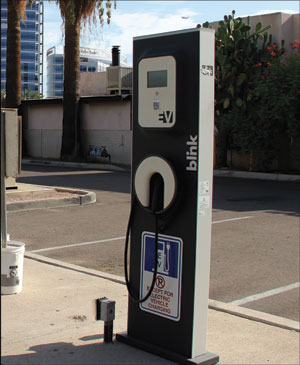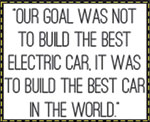Solving Road Range Rage
BY STEPHANIE LOUGH
 I can remember the first time I saw electric car charging stations, back when the word “hybrid” was used almost exclusively for mixed-species plants and animals – it was at Scottsdale Fashion Square. Since I knew this mall better than I knew the halls of my high school, the short row of “special looking” spaces immediately caught my eye. Further investigation uncovered that those spaces were for reserved for electric cars – a place to charge their batteries.
I can remember the first time I saw electric car charging stations, back when the word “hybrid” was used almost exclusively for mixed-species plants and animals – it was at Scottsdale Fashion Square. Since I knew this mall better than I knew the halls of my high school, the short row of “special looking” spaces immediately caught my eye. Further investigation uncovered that those spaces were for reserved for electric cars – a place to charge their batteries.
That was well over a decade ago, and the spots are no longer there – I don’t remember when they were removed. I do remember that I never once saw a car charging. I recently learned from Steve Helm, assistant vice president of property management for the Macerich Company that owns the upscale shopping center, those charging stations were installed in the late ’90s when some auto manufacturers were testing electric cars, and were removed when the testing was discontinued only a few years later.
Little did I know that those parking spaces foreshadowed Scottsdale Fashion Square’s future in supporting the automotive industry’s green movement.
SHORT CIRCUITED
 Auto manufacturing companies have been researching and producing electric vehicles over 100 years, but have always struggled to appeal to mass markets. Every study and test since its inception cited the same reason as to why consumers preferred petroleum engines to battery powered: range anxiety.
Auto manufacturing companies have been researching and producing electric vehicles over 100 years, but have always struggled to appeal to mass markets. Every study and test since its inception cited the same reason as to why consumers preferred petroleum engines to battery powered: range anxiety.
Range anxiety – it’s the feeling we’ve all experienced when the “low fuel” light turns on and you’re unsure if you’ll make it to the next gas station. It’s the fear of being stranded with no way to power your only means of transportation.
But unlike the average mid-sized gasoline powered engine which can get up to 400 miles per 16-gallon tank on the highway, the majority of electric cars today average 80 miles per charge. Depending on the battery, a full charge could take a few hours and it is recommended that they be plugged in overnight – hardly convenient for those embarking on long-distance trips.
While this may sound like a reasonable concern, data from the 2009 National Household Travel Survey showed that 95 percent of single-trip car rides were less than 30 miles, with the average distance just under 6 miles.
Regardless of how the average car-driving American actually behaves, perceptions are what motivate actions.
This attitude is a big problem for electric car manufacturers and environmental activists alike – both groups wanting to see electric cars’ future success, but for very different reasons – as shown in the popular 2006 documentary “Who Killed the Electric Car?” The film depicts automakers’ efforts to bring electric cars to mass market in the late ‘90s, in which thousands of all-electric cars including GM’s EV1, Nissan’s Altra EV and Toyota’s RAV4 EV were released with less-than-profitable results. The powerful automotive corporations decided to pull the plug on the project, and in a controversial move, GM recalled and destroyed all existing EV1 models, effectively killing the electric car. Or so the filmmakers would have us believe.
Despite the ultimate demise of the EV1, the electric car was hardly dead. The 10 years following its extinction were dominated by a compromise of sorts – a low-emissions vehicle that ran on both an internal combustion engine and an electric motor, known as a hybrid.
Toyota has dominated the hybrid market with the Prius, and in 2011, GM introduced what the U.S. Environmental Protection Agency (EPA) rated as the most fuel-efficient compact car with a gas engine, the Chevrolet Volt. According to consumer reports, the Volt EPA-rated fuel economy ranges from 95 mpg city to 40 mpg highway.
Nissan also continued to pursue electric success. In 2010, Nissan introduced the LEAF (Leading, Environmentally friendly, Affordable, Family car) which can travel 100 miles on a full charge. Since its release, more than 35,000 units have been sold, worldwide making the LEAF the world’s top-selling electric car.
Prices continued to drop as well. The average hybrid cost upwards of $40,000 in 2005 and electric vehicles were $50,000 or more, typically twice the amount of their gasoline equivalents. Today, hybrids are much more affordable, starting at about $25,000, and the all-electric LEAF starts around $32,000.
It is still early to tell if this new fleet of electric and semi-electric cars has what it takes to ease range anxiety, but some researchers are saying they still fall short. Research on drivers’ attitudes, by global management consulting company Accenture, found the “magic number” – that is, the distance per charge consumers would feel confident enough driving – to be about 270 miles.
Today, only one company has crossed that marker in the race to end range anxiety…
SCOTTSDALE E-CHARGE
Back to where this story began: Scottsdale Fashion Square. The upscale shopping center that prides itself in its unique, upscale retailers has welcomed a new tenant offering some of the luxury mall’s priciest merchandise: the Model S by Tesla Motors.
Tesla Motors first established itself as an industry leader in 2008 by being the first to use ion lithium batteries in their Roadster, which sold to the tune of $100,000.
The Tesla Roadster was discontinued this year, but their new Model S is rapidly gaining popularity. Thanks to the customizable features and battery packages, the Model S is somewhat more affordable at $49,000.
The three different battery package options for the Model S are the 40 kWh, 60 kWh and 85 kWh, the last of which has been EPA rated to reach distances of 265 miles on a single charge, far more substantial than previous electric cars and currently the longest range of any electric vehicle.
According to Tesla Motors’ communication manager Shanna Hendriks, depending on your electricity provider, the approximate cost for electricity to power the average commute is under two dollars, about half of what a single gallon of gas costs today.
Tesla Motors expects to not only be a strong competitor in the electric car industry, but also to be considered in the same league as traditional combustion engine vehicles – with its best-in-class aerodynamics, and a low center of gravity, it has the ability to accelerate from 0 to 60 in just 4.4 seconds.
“Our goal was not to build the best electric car, it was to build the best car in the world,” Hendriks said. “A vehicle that will raise the bar for vehicle efficiency while meeting the highest standards for safety.”
In addition to bringing a more energy-dense battery to the market, Tesla has also revolutionized how consumers dispose of batteries, an environmental hazard if not done properly.
Tesla’s closed-loop battery recycling program takes dead batteries (typically after 7-10 years of use) and recycles them for use in plastics, new batteries, and other car parts.
Reaching nearly 300 miles per charge and taking further steps to ensure the ultimate in sustainability has surely piqued the interest of some former skeptics, but the car itself is only half of the equation.
It needs to be plugged in.
PAVING THE WAY
Scottsdale Fashion Square is preparing for the next generation of automobiles with plans to add charging stations in the mall’s south end parking garage as soon as December of this year.
According to Helm, Macerich plans to equip all its 70 shopping centers in the Southwest, including Biltmore Fashion Park and Kierland Commons, with charging stations soon.
Some automakers have taken it upon themselves to supply their drivers with conveniently located charging stations. Nissan is working with state and regional government bodies in Seattle and Portland to install quick-charge stations. GM is working to install stations throughout Michigan and Minnesota.
Electric transportation technology company ECOtality Inc. is heading one of the largest electric vehicle charging station projects here in Arizona, between Phoenix and Tucson. The majority of operations and employees of the San Francisco-based company are actually located in Phoenix.
Of course, owners of electric vehicles are able to charge their cars at home too, but more powerful public charging stations will be able to charge batteries in a fraction of the time. Along with growing the infrastructure, many companies are looking into alternative energy sources like solar panels.
THE LONG ROAD AHEAD
There is no doubt that eradicating range anxiety has been, and will continue to be, no easy task. But every day we are getting closer to that certain combination of efforts that will change consumer behavior and advance the development of technology to align more with the way our society operates. The future is uncertain, but the recipe is right.
In a country so heavily dependent on personal automobiles – and a tumultuous relationship with the countries exporting oil – the only certainty is our need for no emission vehicles. It has moved beyond being a “green trend,” into a necessity for the health and well-being of ourselves and our environment.
What will the destiny of electric cars be? Will oil companies retaliate? Or can we expect to see gas pumps eventually replaced by electrical outlets?
Only time will tell.







Don’t fotget all the other 100% electrics that have just come out or are due this year. FORD has the FOCUS EV then there is the MiEV from Mitsubishi and the new GM Spark due any day.
The LEAF is now made in TENN USA ! and has been improved and the price redced. Always lease an electric because they are changing and improving so fast. Lots of new features too.
Life cycle cost are very low, with no oil changesd, no gas, not even a transmission is needed. Combine they with solar and you have a great investment !
Great suggestions!